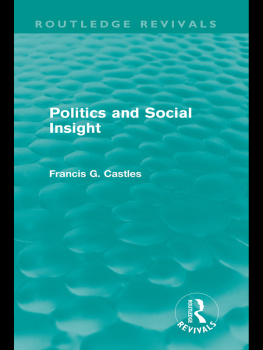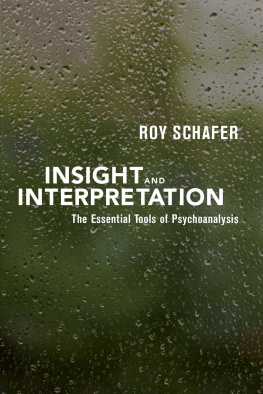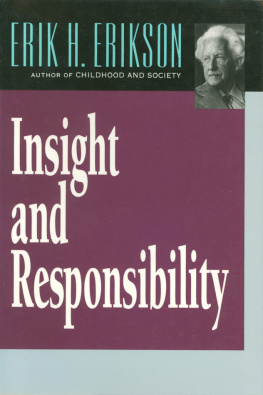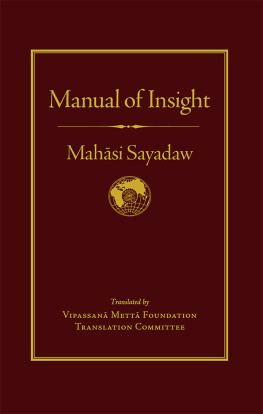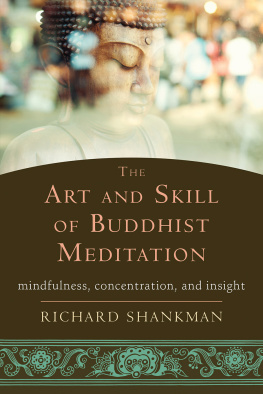Evolving Insight
- Great Clarendon Street, Oxford, OX2 6DP,
- United Kingdom
- Oxford University Press is a department of the University of Oxford.
- It furthers the Universitys objective of excellence in research, scholarship,
- and education by publishing worldwide. Oxford is a registered trade mark of
- Oxford University Press in the UK and in certain other countries
- Oxford University Press 2016
- The moral rights of the author have been asserted
- First Edition published in 2016
- Impression: 1
- All rights reserved. No part of this publication may be reproduced, stored in
- a retrieval system, or transmitted, in any form or by any means, without the
- prior permission in writing of Oxford University Press, or as expressly permitted
- by law, by licence or under terms agreed with the appropriate reprographics
- rights organization. Enquiries concerning reproduction outside the scope of the
- above should be sent to the Rights Department, Oxford University Press, at the
- address above
- You must not circulate this work in any other form
- and you must impose this same condition on any acquirer
- Published in the United States of America by Oxford University Press
- 198 Madison Avenue, New York, NY 10016, United States of America
- British Library Cataloguing in Publication Data
- Library of Congress Control Number: 2015947529
- Printed and bound by
- CPI Group (UK) Ltd, Croydon, CR0 4YY
- Oxford University Press makes no representation, express or implied, that the
- drug dosages in this book are correct. Readers must therefore always check
- the product information and clinical procedures with the most up-to-date
- published product information and data sheets provided by the manufacturers
- and the most recent codes of conduct and safety regulations. The authors and
- the publishers do not accept responsibility or legal liability for any errors in the
- text or for the misuse or misapplication of material in this work. Except where
- otherwise stated, drug dosages and recommendations are for the non-pregnant
- adult who is not breast-feeding
Acknowledgments
In writing this book, I have continually been reminded of my debt to the excellent PhD students, research assistants, and postdoctoral fellows with whom Ive had the pleasure of working for many years. The ideas developed here were all worked out while working jointly with them, andthough their names occur often in the referencesprobably owe more to my collaborators than the raw text would seem to suggest! Their topics have spanned all the groups of animals that feature prominently here: prosimians (April Ruiz), monkeys (Peter Henzi, in collaboration with my colleague Andy Whiten; Rob Barton, Kate Harrison, Heather McKiggan, Mindy Babitz, Patti Teixidor, Rogrio da Cunha, Alexandra Valero, Karline Janmaat, Rahel Noser, and Cris Csar), and great apes (gorillas: Jen Byrne, Joanne Tanner, and Emilie Genty; orangutans: Erica Cartmill; chimpanzees: Emma Stokes, Nadia Corp, Lucy Bates, Cat Hobaiter, Katie Hall, Hlne Cochet, and Brittany Fallon; and bonobos: Lisa Orr and Kirsty Graham); not to mention elephants (Lucy Bates, again, and Anna Smet) and pigs (Suzanne Held, in collaboration with Mike Mendl at the University of Bristol). Without you lot, I might not have had anything to write about: thank you! Special thanks are due to those who heroically read and gave me comments on the book itself: Cat Hobaiter and Lucy Bates, both of whom have been such fine colleagues for so long.
1 Introduction
What is insight, and why care about its evolution?
Abstract and Keywords
This chapter explains the problem that the book aims to tackle: to develop a new theory of the evolutionary origin of insight in human ancestry. Insight refers to the ability to inspect and manipulate mental representations away from the things they represent in the external world. We take that ability for granted in everyday life, but it may be rather rare in the animal kingdom. After showing why a cognitive approach rather than one based on learning theory is essential, the book will survey potential areas for showing insight: the aim is to understand how humans acquired insight, so the central focus will generally be on primates. Insight is most often reported in the domains of communication and social understanding, but the evolutionary trajectory toward insight may instead have been driven by the interpretation of skillful behavior by means of behavior parsing, needed for social learning of elaborate motor skills.
Insight is not a very popular word in psychology or biology, but that is actually partly the reason why I chose it for the title. Popular termslike intelligence, planning, complexity, or cognitivehave a habit of sprawling out to include everyones favorite interpretation, and end up with such vague meanings that each new writer has to redefine them for use. Insight remains in everyday usage: as a down-to-earth, lay term for a deep, shrewd, or discerning kind of understanding. Insight is a good thing to have, so its important to find out how it evolved, and thats what this book is about. (Strictly speaking, of course, insight doesnt evolve, it dawns. But that linguistic awkwardness is no better with the word understanding, and with insight it will be particularly clear to readersI hopethat what I mean is the evolution of the capacity for having insights.)
If you look past the everyday sense of insight, you soon meet Khlers chimpanzee, Sultan. Sultans behavior is the stuff of Comparative Psychology 101. During the Great War, when Wolfgang Khler was interned on Tenerife and spent his time studying the captive colony of chimpanzees there, Sultan was his star subject. Khler had presented chimpanzees with a range of tasks, including the use of a rake to get foods that were out of reach even to the long arm of a chimpanzee. Sultan was good at raking, but he was stumped when Khler gave him several short sticks, none of them long enough to reach the food. After a while, Sultan gave up and simply sat next to some of the sticks. Then insight dawned. While fiddling with the sticks for no apparent purpose, Sultan happened to push two sticks togetherand they held, making a longer stick. Sultan suddenly became animated, took the sticks across to the out-of-reach food, and used his new, combined tool to reach it, with immediate success! That is insight, as described in many psychology texts: the Ah ha! moment. Trouble is, its not quite clear what took place for Sultan to give him the insight. Subsequent replications with chimpanzees reared in relatively deprived circumstances have (p.2)shown that the revelation only happens to individuals that have had the chance, as children, to play with sticks and other objects. Long experience, as well as an Ah ha! moment, seem to be necessary. And what actually happens in that Ah ha! moment, anyway? It smacks of unconscious thought, and explaining an observed phenomenon with something even more mysterious is not satisfying.
In this book, I will treat insight as the ability to inspect and manipulate a mental representation of some part of the world, when away from any opportunity to see or in any other way to perceive it directly. Mental representation is a useful technical term in psychology: a mental representation of something in the world is the brain structure that enables us to think about it. For example, you know your way around your home very well: if asked, you can explain how to get from the lounge to the kitchen, what is directly below the spare bedroom, and what you can see from the dining-room window. That means, in psychological terms, you have a mental representation of the house, which you can not only use to direct your actions, but also manipulate and inspect mentally, in order to answer those questions when you are asked, even if you are nowhere near the house at the time. This representation need notin fact, is most unlikely topreserve every detail of the real world. We do not have photographic memories, and our knowledge even of our own homes is not equivalent to a set of architects drawings; nor would it be useful to have such accuracy and completeness, since wed be bogged down with trivia. What is important for a mental representation is that it encodes useful information, and can be manipulated in the mindthe process we call thinking in everyday talk. Insight is therefore about thinking.


